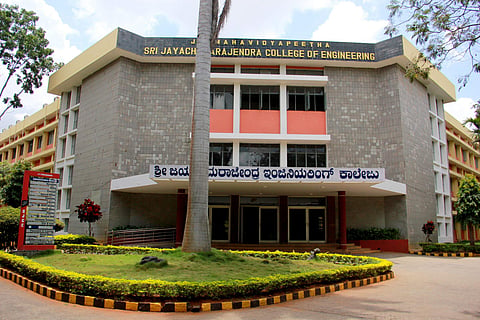

Students from the Electronics and Communication Engineering Department of Sri Jayachamarajendra College of Engineering (SJCE) have developed a self-powered navigation system to aid the visually-impaired by generating the embedding transducers in their shoes.
Students A Anusha, S Ashwini, CB Divya and MH Kalpana, under the guidance of Shivaprasad N, assistant professor, Department of E and C, have developed the device. They have worked hard for six months to improve the quality of the gadget.
Energy generated through walking
The students have used different sensors, such as ultrasonic sensors to detect obstacles, water sensors to detect water, and vibration sensors to detect vibration. They have also incorporated GPS and GSM systems to track and send the location of the disabled person to their tracking person caretaker (caretaker). Without seeking anyone's assistance, the disabled person can navigate both indoors and outdoors with the help of audio commands issued by the gadget. The power required for operating the unit is obtained from the energy that is generated when the person walks. Moreover, the shoe is integrated with self-power generation unit, and there will be no power-backup problems.
When an object is detected near the shoe, the disabled person gets notified with the help of speakers. Also, if the person starts to panic and needs immediate help, there is a panic button that sends an SMS to the caretaker. With the help of ultrasonic sensors, speakers announce accurate information about the object detected. If the disabled person meets with an accident, the vibration sensor detects it. Using the GSM and GPS modules, an SMS is sent to the tracking person immediately, which contains the Google map link with the exact location.
“This model is very useful to both the blind and people with Alzheimer's (with necessary modifications). The durability of the model depends on the lifespan of the rechargeable battery used to store the energy from the piezoelectric sensors, says Dr Shankaraiah, professor and HOD.
Drawbacks in existing mobility aids
“Though there are many ways to generate electricity, footstep energy generation is an effective method for the model we have developed. In this method, piezoelectric transducers are used to produce electricity. In the footstep power generation technique, when the pressure applied by the individual on the floor changes, the piezoelectric transducer converts it into electrical energy. This generated power can then be used in many applications, says Anusha, explaining the technical jargon.
In some mobility aids, IR sensors are used as object-detecting sensors. The problem associated with these models is that they are less-efficient and less-accurate in detecting obstacles. The drawback with these aids is the restricted range of mobility and very little information conveyed, says Divya.
“When a single piezoelectric transducer is embedded inside the shoe of a person weighing 50kg, it was observed that if he applied pressure for just five minutes, it generated voltage of around 2V, which is not enough to switch on the navigation system. This was a major problem. So we tried different configurations of transducers to generate the required power.
A series-parallel combination of six piezoelectric sensors has been deployed to get the required voltage of 8V. This is sufficient for the entire system to function,” adds Kalpana. Shivaprasad N, who guided the students in their venture, says that around 8.8 million people in India are suffering from blindness or visual impairment, according to a study.
They are dependent on others for most of their activities. The oldest and traditional mobility aids for persons with visual impairment are walking canes and guide dogs, he says.
